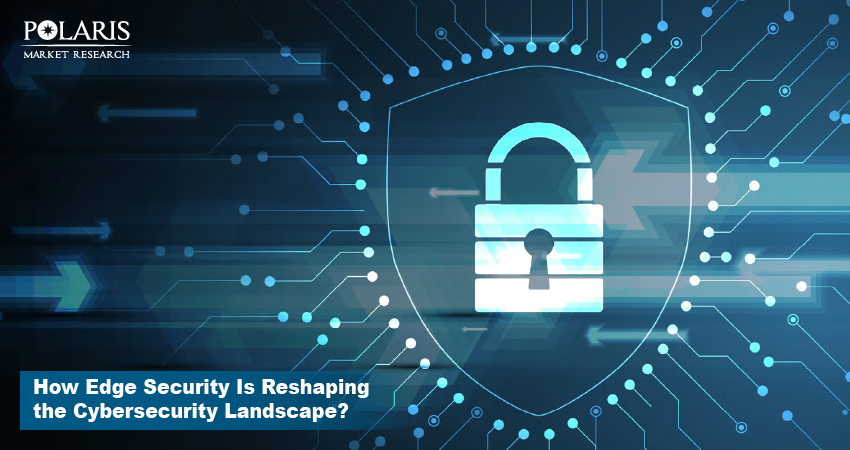How Edge Security Is Reshaping the Cybersecurity Landscape?

In today’s fast-paced digital environment, companies are increasingly embracing technologies that take computing closer to data generation. That is on the edge. With the growing proliferation of edge computing across industries, there is a heightened need to secure these distributed ecosystems. Edge security is a rapidly evolving demand in the cybersecurity landscape that’s redefining how organizations protect data, applications, and devices beyond the traditional data center.
This blog post takes you into the fascinating realm of edge security, explaining its basics and key components. Additionally, we shed light on the current state of the edge security market and outline the key factors driving market growth. Stick with us!
Edge Security: Introduction
Edge computing moves data processing and storage closer to the physical location of data sources, rather than relying solely on centralized data centers. By taking computing resources closer to these locations, edge computing allows organizations to minimize latency and reduce network bandwidth usage.
Edge security is a type of decentralized security infrastructure for enterprises. It encompasses various tools and practices used to protect edge infrastructure and workloads in remote locations, where on-site expertise is limited. It involves safeguarding valuable data that is generated outside a company’s on-premises data center or public cloud. Edge security plays a vital role with the growing attack surface and scaling of the edge architecture.
Components of Edge Computing
Effective edge computing encompasses various key components. These include:
Edge Device Security
Edge device security focuses on protecting the devices that operate at the network’s edge. Devices such as smartphones, laptops, and IoT devices are often outside the cloud infrastructure or a traditional data center. These devices are often used to collect, process, and transmit sensitive information. Edge device security involves securing them against threats and unauthorized access.
Cloud Security
In the context of edge computing, cloud security encompasses the measures taken to protect data and infrastructure when leveraging cloud services for edge-based operations. It ensures the confidentiality and integrity of resources that are processed and accessed at the edge of the network. It extends the principles of cloud security to distributed environments. The key aspects of cloud security in edge environments include data protection, network security, access control, threat detection and response, and compliance and governance.
Network Edge Security
Network edge security is a crucial component of an organization's overall security strategy. It focuses on protecting the network perimeter and the devices connected to it. Network edge security encompasses various technologies and practices designed to secure the network’s boundary and ensure controlled access to resources and data. As a decentralized approach, it applies security to the network’s edge, rather than relying solely on a centralized security point.
Working of Edge Security Explained
Edge security surpasses traditional appliances by offering solutions that extend security from the cloud to remote assets. It doesn’t directly safeguard the endpoint device, cloud application, or data center. However, it does allow for the creation of a monitored connection between them all.
The nature of security layers deployed between cloud resources, data centers, and edge assets is largely based on the type of technology being used. In all scenarios, the technology must protect against attacks and facilitate secure connections. More advanced edge security solutions are also context-aware and offer different levels of connections based on edge devices, users, and data types. Key providers also include artificial intelligence (AI) and machine learning (ML) analytics into their offerings.
Key Market Metrics
Our latest market analysis reveals that the edge security market is poised for sustained growth in the years to come. With a CAGR of 20.7% between 2025 and 2034, the market is projected to grow to USD 172.50 billion by 2034.
The increasing use of AI and ML in edge devices is driving the need for localized security models that can detect and mitigate threats in real-time. The expansion of endpoint volume due to the growing integration of 5G networks with edge computing is further contributing to increased demand for security solutions aimed at ultra-low latency environments.
Major Options for Edge Security
Below, we’ve given some of the major options for edge security:
Firewall-as-a-Service (FWaaS)
FWaaS providers typically replace secure web gateways (SWGs) and next-generation firewalls (NGFWs) within an organization. They deliver firewall functionality through the cloud, allowing organizations to manage security policies from a centralized platform. FWaaS can be used as a replacement or supplement for existing on-premise firewalls. It is typically beneficial for organizations with distributed networks or cloud-based infrastructure.
This cloud computing security model provides networking services, including bandwidth, security, and management, to users on a subscription basis. NaaS enables organizations to access and manage their network infrastructure without owning or maintaining their own hardware or software. In essence, it transforms traditional networking into a utility.
Secure Access Service Edge (SASE)
SASE converges networking and security services into a unified platform. It aims to provide secure and reliable access to applications and data for users by integrating functions like SD-WAN, secure web gateways, and cloud access security brokers. Essentially, SASE moves security controls to the network edge, rather than relying solely on a centralized data center approach.
Security Service Edge (SSE)
SSE is the security-focused component of the SASE framework. It provides cloud-based security services to access web, SaaS, and private applications. SSE encompasses a range of security capabilities, including Zero Trust Network Access (ZTNA), Secure Web Gateway (SWG), and Cloud Access Security Broker (CASB). Essentially, SSE secures users and devices accessing resources from anywhere.
To Conclude
The edge security market is constantly evolving. Organizations are increasingly seeking to move their networks even further to the edge as the world shifts towards a remote environment. With the increasing complexity of network infrastructure and security, many companies are partnering with professional security experts to enhance cost-effectiveness and efficiency.

